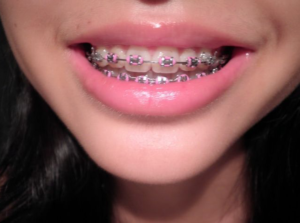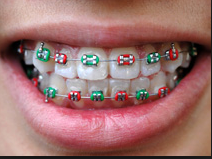Why Braces, what do you think?
Orthodontics has come a long way since the days of “metal mouth.” New technology is allowing treatment to be more comfortable, less visible, and more efficient. New cosmetic braces that have clear or tooth colored brackets are now available that minimize the appearance of braces. Another method, called lingual orthodontics, affixes the brackets behind the teeth and out of sight. Overall treatment times are now shorter and require fewer appointments. These are just bonuses to the real reasons for getting braces – a healthy and beautiful smile.
By gradually straightening the teeth, braces can improve your smile or your child’s smile and overall appearance. Aligning the teeth, lips and jaws makes teeth easier to clean -significantly improving overall dental health. And what many people don’t realize is that orthodontics will, in turn, boost self-confidence – giving you or your child smile power!
Who Needs Braces?
Beyond providing a great smile, orthodontics also corrects “malocclusions” or bad bites. A malocclusion (the term for crooked, crowded or protruding teeth) occurs when the teeth are not lined up properly. Malocclusions can affect the way a person chews, talks or smiles, and in some cases, can affect the jaws causing pain and discomfort. Below are some common conditions treated with orthodontics:
Crowded Teeth – When teeth are crooked, crowded, turned or spaced too far apart. (include photo/diagram).
Overbite – When the upper jaw or teeth are too far in front, or when the lower jaw or teeth are too far back. (include photo/diagram)
Underbite – when the lower jaw or teeth are too far in front, or when the upper jaw or teeth are too far back. (include photo/diagram)
Overjet (Protrusion) – when upper teeth protrude and do not fit properly together with the lower front teeth
Spacing- when teeth have gaps or spaces between them
In these cases, orthodontists will recommend braces or other appliances to correct the problem and straighten your teeth.
Standard orthodontic appliance or braces have three basic parts:
Brackets, which are the small metal or ceramic modules individually attached to each tooth. They serve as a guide to move the teeth and hold the archwire in place. Brackets are attached to the teeth with a tooth colored bonding adhesive.
Bands, which are the larger metal rings that sometimes are placed on back teeth for strength and anchorage. These are attached to the teeth with adhesive cement and separators (small elastic rubberbands) are placed between the back teeth prior to placing these bands on the teeth.
Archwires, which are the wires that you see connecting each arch and running form bracket to bracket. Archwires are changed periodically during your treatment time.
How long will treatment last?
Braces are used to straighten your teeth gradually – not overnight – so a little patience is needed during the process. You can expect the average single-phase treatment time to last 18 to 24 months depending on the severity of your or your child’s correction needs. Patient cooperation with every step of the prescribed treatment plan is essential to the success of treatment. This means wearing the appliances as prescribed, keeping your scheduled appointments and keeping the teeth extra clean. Your orthodontist will use braces to produce slight pressure on each tooth and make regular adjustments to maintain this directional pressure. The teeth and jaws may be a little sore after each visit, but the discomfort will be brief. The end result of a beautiful healthy smile is well worth it!
After the braces are removed, the orthodontist will prescribe a retainer to be worn continuously for a few months to a few years to set the tissues surrounding the newly straightened teeth. Retainers are usually worn on a consistent basis until the wisdom teeth have either fully erupted or been removed. After such time, you may need to wear your retainers just at night or periodically to make sure your teeth don’t move. You may also be fitted with a permanent retainer, a metal wire bonded to the back of your teeth, to ensure that your teeth stay in the proper position. Commitment to retention will keep that new beautiful smile perfect for a lifetime! If you lose a retainer or break a retainer be sure to call your orthodontist office immediately and have a replacement one made.
The true test
The most important question to answer in deciding whether to get orthodontic treatment or not is to ask yourself or have your child ask “Do I like my smile?” If the answer is no and orthodontics can help, then it is one of the best investments you can make in yourself or your child’s future.

0 Replies to “Why Braces, what do you think”